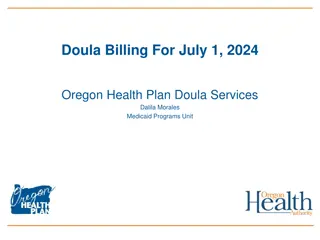Understanding Critical Care Billing and Definition
Critical care billing is essential for healthcare providers to get proper reimbursement for treating critically ill patients. This includes direct delivery of medical care for patients with vital organ system failure, requiring high complexity decision-making and advanced technology. Critical care services are time-based and must meet specific criteria for billing. It is crucial to understand the definitions and guidelines to ensure accurate billing and reimbursement.
- Critical Care Billing
- Healthcare Billing
- Medical Reimbursement
- Critical Care Definition
- High Complexity Care
Download Presentation

Please find below an Image/Link to download the presentation.
The content on the website is provided AS IS for your information and personal use only. It may not be sold, licensed, or shared on other websites without obtaining consent from the author. Download presentation by click this link. If you encounter any issues during the download, it is possible that the publisher has removed the file from their server.
E N D
Presentation Transcript
Critical Care Billing Seth Lotterman, MD Hartford Hospital and University of Connecticut Emergency Medicine Residency
Why do I care? Get paid for what you did!!
Critical care background info Critical care time (30-74 minutes) reimbursed $226.80 (per 2018 Medicare Physician Fee Schedule For comparison: Level 4 visit (99284) 3.32 RVUs = $119.52 Level 5 visit (99285) 4.89 RVUs = $176.04 8.1% of ED visits have critical care time claimed emergency* *CMS 2016 Medicare Utilization Data by Specialty 93 National: For Claims Processed
Critical Care definition Direct delivery of medical care for a critically ill or critically injured patient Critical care illness or injury acutely impairs one or more vital organ systems such that there is a high probability of imminent or life- threatening deteriorationin the patient s condition Ex. CNS failure, metabolic system failure, renal failure, hepatic failure, respiratory failure, shock/circulatory failure
Critical care definition, cont. Critical care involves HIGH complexity decision making to assess, manipulate, and support vital organ system function(s) to treat single or multiple vital organ system failure and/or to prevent further life-threatening deterioration of the patient s condition Typically requires interpretation of multiple physiologic parameters and/or application of advanced technology, but does NOT have to
Critical care definition, cont. Critical care is a time-based code, requires > 30 minutes of time CPT code 99291 is used for minutes 30-74 CPT code 99292 is used for each additional 30-minute time interval Must pass 15 minutes of next time 30-minute increment to get credit for the 30 minutes interval of critical care time Time does not need to be continuous, but total must meet minimum time requirement Clock resets at midnight, but can bill episodes of critical care on separate days, as long as the patient s condition remains critically ill If a patient arrives just before midnight and the total 30-74 minutes of critical care spans 2 calendar dates can be considered a single episode of critical care Service must be medically necessary, not location dependent can be delivered anywhere in the hospital
Examples of critical care patients Patient experiencing respiratory failure requiring ventilatory support Patient in circulatory failure requiring vasopressors Patient with unstable angina treated with intravenous nitrates, beta blockers, and anticoagulation GI bleed requiring fluid resuscitation and/or transfusion Patients with SIRS/sepsis may also meet critical care criteria
Conditions that frequently qualify for critical care billing Acute coronary syndrome with active chest pain Acute hepatic failure Acute renal failure Acute respiratory failure Adrenal crisis Aortic dissection Bleeding diatheses aplastic anemia, DIC, hemophilia, ITP, leukemia, TTP Burns threatening to life or limb Cardiac dysrhythmia requiring emergent treatment Cardiac tamponade Coma (most etiologies, except simple hypoglycemic) Diabetic ketoacidosis or non-ketotic hyperosmolar syndrome Drug overdose Ectopic pregnancy with hemorrhage Embolus of fat or amniotic fluid Envenomation Gastrointestinal bleeding Head injury with loss of consciousness Insulin infusions Medications for heart rate/rhythm control Naloxone infusions Vasoactive medications Hyperkalemia Hyper- or hypothermia Hypertensive emergency Ischemia of limb, bowel, or retina Lactic acidosis Multiple trauma Paralysis (new onset) Perforated abdominal viscous Pulmonary embolism Ruptured aneurysm Shock, all etiologies (septic, cardiogenic, spinal, hypovolemic, anaphylactic) Stroke, hemorrhagic (all etiologies) or ischemia Status epilepticus Tension pneumothorax Thyroid storm From ALiEM ED Charting and Coding: Critical Care Time https://www.aliem.com/charting-coding-critical-care- time/
Examples that do NOT meet critical care Need to have actual condition, not just potential for severe disease i.e. trauma pt with severe mechanism, but has negative work up would NOT count as critical care Severe condition, such as STEMI, but physician only spent 15 minutes caring for the patient before they went to the cath lab
Ok for discharged patients? Can be billed on discharged patients as long as the chart reflects a condition with potential organ failure and an intervention that improved the patient s condition, but this is a less common occurrence Example: asthmatic patient who received multiple nebulizers, steroids, magnesium and improved over several hours to be discharged
What is included? Multiple facets of care are included in critical care time, such as: Imaging interpretation Collection and interpretation of physiologic data (pulse ox, ABG/VBG, cardia output measurements) OGT/NGT Temporary transcutaneous pacing Vent management Vascular access (not including CVC or IO)
Whats included? Time component of critical care also includes: Time at the bedside Discussing case with family and consultants Reviewing test/imaging, Documenting
Whats NOT included (i.e. billed separately) EKG interpretation CVC and IO placement Intubation Cardioversion Tube thoracostomy Temporary transvenous pacemaker CPR
What to chart Evidence of organ system failure or high probability of imminent of life-threatening deterioration Chart does not require all elements of the HPI/PMHx/PE needed to chart level 1-5 charts Although, if critical care billing is not met, chart is coded at next highest level, so good practice to chart to level 5
What to chart Should have a statement that the attending physician provided X amount of time to a single patient with a critical illness/injury that resulted in X organ system failure, or high probability of imminent failure, excluding bedside teaching and other separately billable procedures. Exact time is preferred over a time range (i.e. spent 40 minutes rather than spent 31-74 minutes )
What to chart When charting, try to include the following information to demonstrate critical care that was rendered and support the time component of critical care billing Severity of illness and potential for decompensation Vital signs (hypotension, hypoxia, etc) and how these changed through the case Tests performed and your interpretation of the results Treatments provided: Supplemental oxygen, IV fluids, medications, blood transfusions, burn/wound care https://www.aliem.com/charting-coding-critical-care-time/
What to chart Procedures performed Re-assessments of the patient s status and response to interventions Conversations with EMS, the patient, the patient s family or surrogate decision makers, nursing home personnel, consultants, and admitting teams Information retrieved by chart review and how this impacted patient care https://www.aliem.com/charting-coding-critical-care-time/
Special scenarios Multiple physicians caring for single patient Advanced practitioners caring for patient Teaching physicians
Multiple physicians As long as the care provided by each physician meets critical care definitions, is medically necessary, and is not duplicative care, multiple physicians can bill for critical care time Concurrent critical care by multiple physicians (typically from multiple physician specialties) is payable Services may NOT be shared/split between a physician and non-physician practitioner
Multiple physicians Physicians in the same group, who are within the same specialty, are paid as though they were a single physician
Non-physician practitioners May NOT combine physician and non- physician time with members of same group practice Critical care time by non-physicians is billed separately from physician May NOT bill initial critical care code on same day as physician
Teaching physicians Teaching physicians may tie into the resident s documentation for specific patient history, physical findings, and medical assessment when documenting critical care. The teaching physician must include a statement about the total time he or she personally spent providing critical care. The statement must include that the patient was critically ill when the teaching physician saw the patient, why and what made the patient critically ill, and the nature of the treatment and management provided by the teaching physician. CMS provides the following vignette as an example of acceptable documentation: Patient developed hypotension and hypoxia; I spent 45 minutes while the patient was in this condition, providing fluids, pressor drugs, and oxygen. I reviewed the resident s documentation and I agree with the resident s assessment and plan of care. https://www.aapc.com/blog/24587-ten-commandments-of-coding-critical-care-in-the-er/ (accessed 8/24/2020)
Miscellaneous tips Adding a chart attestation that critical care time was provided for time X with time < 30 minutes can help justify a level 5 chart and if multiple EM physicians in the same group document critical care time with a total > 30 minutes, critical care time can be billed for that visit.
Summary Time based CPT code Need to documenting supporting data to indicate vital organ system impairment with high probability of imminent or life-threatening deterioration in the patient s condition Attending must be immediately available Many facets of care are bundled into the critical care code, but there are multiple procedures that are billed separately Does NOT include time teaching
References 2018 National Physician Fee Schedule Relative Value File, GPCI18, National Physician Fee Schedule Relative Value File Calendar Year 2018, MCR-MUE-Practitioner Services Published by CMS. Effective: April 1, 2018. CMS 2016 Medicare Utilization Data by Specialty 93 National: For Claims Processed with 2016 Dates of Service filed by June 30, 2017 https://www.aliem.com/charting-coding-critical-care-time/ (accessed 8/24/2020) https://www.acep.org/administration/reimbursement/reimbursem ent-faqs/critical-care-faq/#question0 (accessed 8/24/2020) https://www.cgsmedicare.com/partb/mr/pdf/critical_care_fact_sh eet.pdf (accessed 8/24/2020) https://cgsmedicare.com/partb/pubs/news/2020/05/cope17364.ht ml (accessed 8/24/2020)























